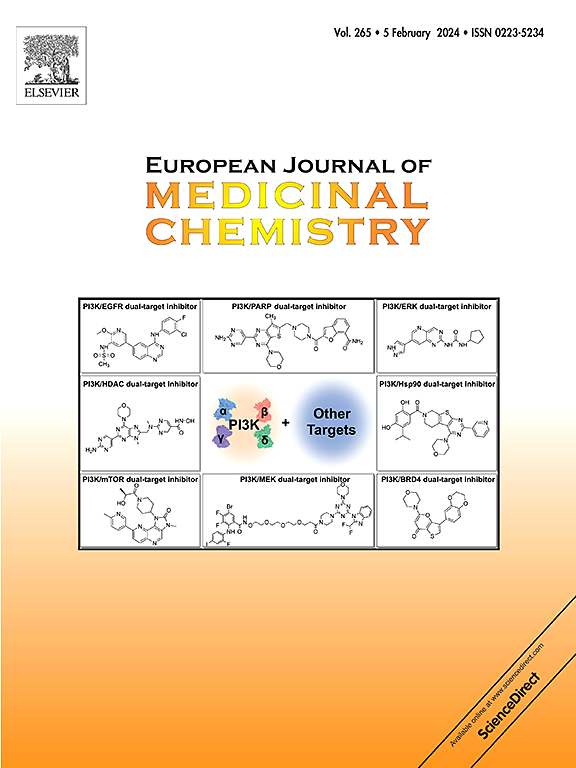Novel boron-modified aza-BODIPY photosensitizers for low-dose light-dependent anti-cancer photodynamic therapy
IF 6
2区 医学
Q1 CHEMISTRY, MEDICINAL
引用次数: 0
Abstract
The aggregation-induced decrease in photosensitization activity is one of the major challenges limiting the clinical application of photosensitizers (PSs). Thus, developing highly efficient PSs for anti-cancer photodynamic therapy (PDT) remains an urgent need. To address this challenge, we designed and synthesized a novel family of efficient aza-BODIPY PSs by inhibiting aggregation with a boron-modified strategy. These novel aza-BODIPY PSs demonstrated significantly enhanced in vitro photodynamic efficacy. Of particular note was derivative A1, which emerged as a highly promising NIR PS with high singlet oxygen yield (rel.rate = 1.79) that obviously superior to the reported compound BDP 4 (rel.rate = 1.23) in PBS. Additionally, A1 showed exceptional cytotoxicity against various cells (IC50 > 4.5 nM) at a low light dose of 21.6 J/cm2. In vivo anti-tumor experiments showed that significant tumor growth suppression following intravenous administration of A1 (2 mg/kg) and subsequent irradiation (21.6 J/cm2, λ = 660 nm), outperforming well-known PSs such as ADPM06 and Ce6. Both in vitro and in vivo studies revealed that A1 exhibited an excellent PDT effect at remarkable low drug and light doses.


新型硼修饰Aza-BODIPY光敏剂用于低剂量光依赖性抗癌光动力治疗
聚集体诱导的光敏活性降低是限制光敏剂临床应用的主要挑战之一。因此,开发用于抗癌光动力治疗(PDT)的高效ps仍然是迫切需要的。为了解决这一挑战,我们设计并合成了一个新的高效aza-BODIPY PSs家族,通过硼修饰的策略抑制聚集。这些新型aza-BODIPY PSs显示出明显增强的体外光动力功效。特别值得注意的是衍生物A1,它在PBS中具有高单线态氧收率(rel.rate = 1.79),明显优于已报道的化合物BDP 4 (rel.rate = 1.23),是一种非常有前途的近红外PS。此外,A1对多种细胞表现出异常的细胞毒性(IC50 >;4.5 nM)在21.6 J/cm2的弱光剂量下。体内抗肿瘤实验表明,静脉注射A1 (2 mg/kg)和随后的照射(21.6 J/cm2, λ = 660 nm)对肿瘤生长的抑制作用显著,优于ADPM06和Ce6等知名ps。体外和体内研究均表明,A1在低剂量和轻剂量下均表现出良好的PDT作用。
本文章由计算机程序翻译,如有差异,请以英文原文为准。
求助全文
约1分钟内获得全文
求助全文
来源期刊
CiteScore
11.70
自引率
9.00%
发文量
863
审稿时长
29 days
期刊介绍:
The European Journal of Medicinal Chemistry is a global journal that publishes studies on all aspects of medicinal chemistry. It provides a medium for publication of original papers and also welcomes critical review papers.
A typical paper would report on the organic synthesis, characterization and pharmacological evaluation of compounds. Other topics of interest are drug design, QSAR, molecular modeling, drug-receptor interactions, molecular aspects of drug metabolism, prodrug synthesis and drug targeting. The journal expects manuscripts to present the rational for a study, provide insight into the design of compounds or understanding of mechanism, or clarify the targets.

 求助内容:
求助内容: 应助结果提醒方式:
应助结果提醒方式:


